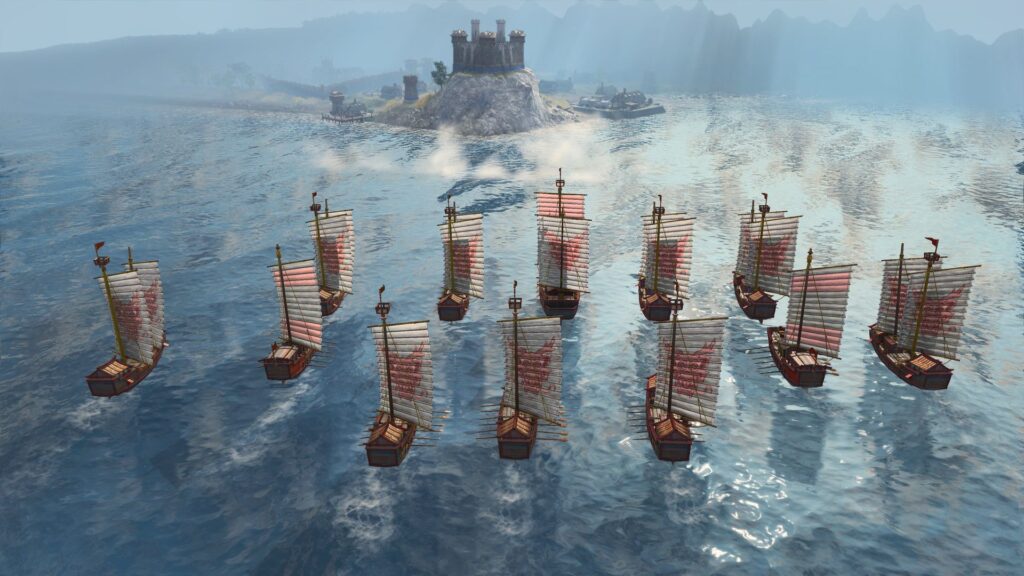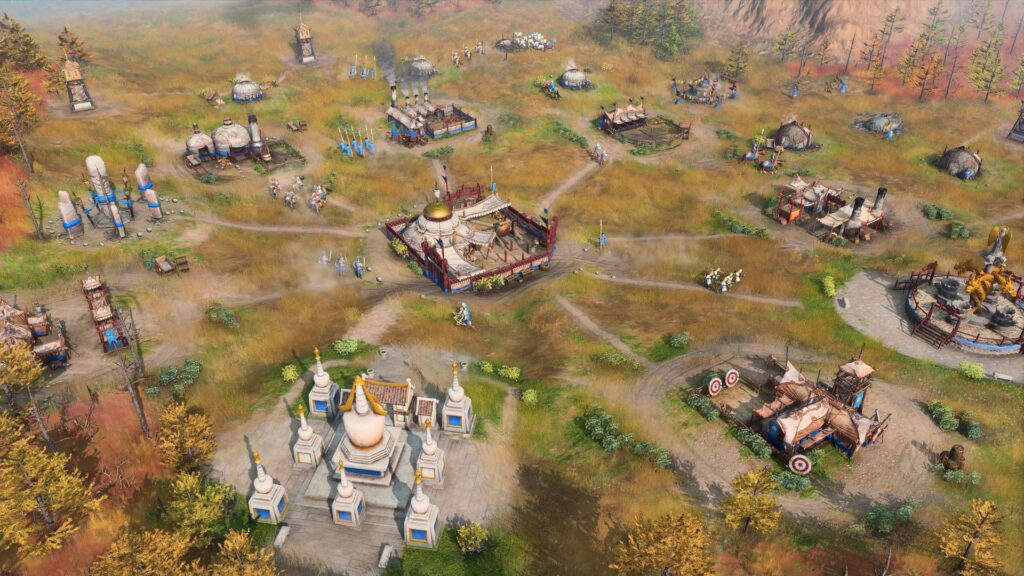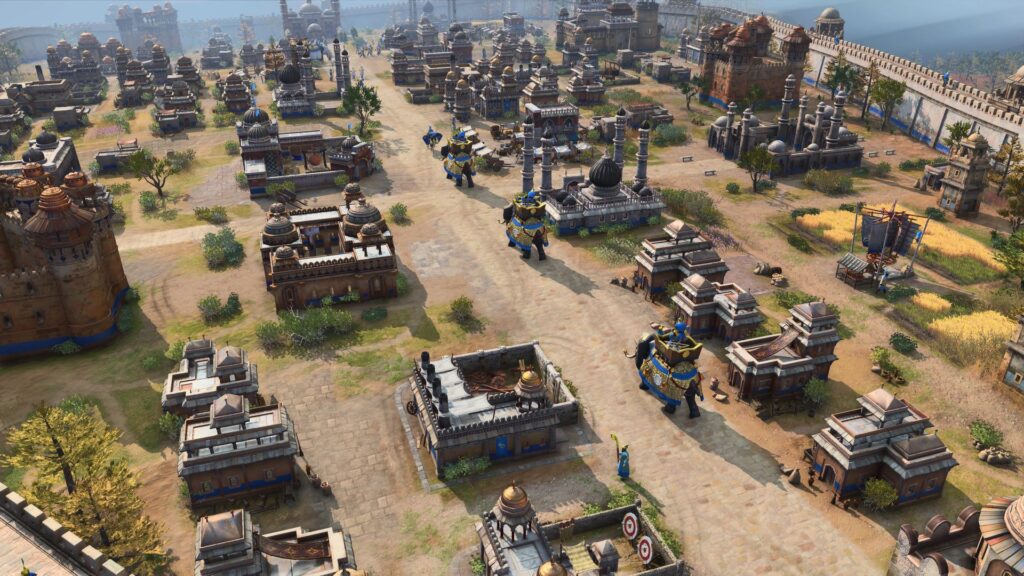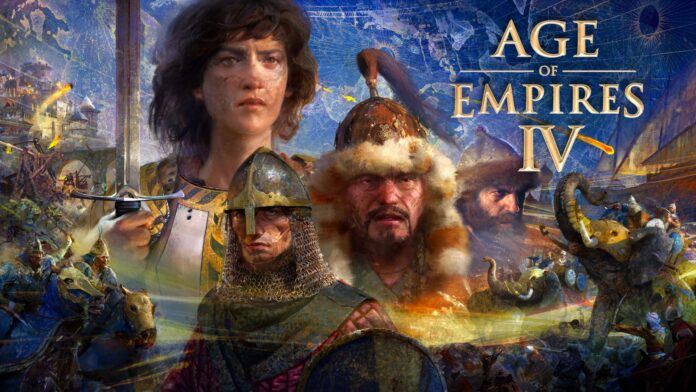It has been sixteen years since the last main entry to the legendary Age of Empires franchise. And a staggering twenty-two years since the proverbial king of the real time strategy (RTS) genre, Age of Empires (AoE) II, graced our PCs and consoles with its presence. Needless to say, I, like many, was losing all hope of a sequel. Nevertheless, a small band of hard-core fans kept the dream alive and fanned the flames of main stream subversion. “To hell with your clash of clans, and all of its brethren, with their predatory micro transactions and mobile simplicity! Give us a real RTS!” they shouted out with fervour and fury, until one day, rumour spread from the West of a wealthy merchant funding the creation of the mythical AoE IV. Could it be true? Will the curse be broken? Then on August 21st 2017 our prayers were answered. The age of real time strategy was coming back.
The original company that created the first AoE back in 1997, Ensemble Studios, went bankrupt in 2009. Hence, why the franchise has remained dormant for so long. The studio tasked with bringing it back was Relic Entertainment, a highly competent company with many other RTS games under its belt such as the Dawn of War and the Company of Hero’s franchises. However, this left some fans feeling concerned that Relic’s style of squad based action packed RTS wouldn’t translate well over to AoE’s more single unit, base building, resource gathering gameplay philosophy.
Well I am very happy to report that I can put those fears to rest. Relic has done an outstanding job of recreating AoE’s play style. From the rock paper scissors combat to its historically accurate single player campaign. In fact, if anything it has done too good of a job, I sometimes forget I’m even playing a new game! That’s not to say that there are no changes, just that there are very few. Relic clearly didn’t want to rock the galleass with this one and it shows.

WHAT IS AGE OF EMPIRES IV?
At its core AoE IV is a historically themed real time strategy game with combat, base building, and resource gathering as its basic gameplay mechanics. Traditionally Players are limited to a total of two hundred units including boats and siege engines. You can play as one of several historical civilisations, including but not limited to: The Mongols, the Rus, the Holy Roman Empire and so on, fighting to win under one of three conditions. You can win a match by capturing and holding two sacred sites on the map for 15 minutes, constructing and then defending a wonder for 10 minutes, or finally crushing your opponent militarily by destroying their landmarks (more on landmarks later). This means to achieve any of these objectives, you have to carefully balance your economy with the size of your military. Since this is because “villagers”, your resource gatherers, take up one of the unit slots each, while boats and siege engines can take up multiple slots. So you can’t just make one villager and spam your most powerful fighters or vice versa. This encourages you to think tactically about what’s needed in the present or ten minutes into the future and to optimise your economy or military accordingly.
Speaking of AoE’s economy there are four resources to gather (none of that two resource simplicity here). They are food, wood, gold, and stone. Wood and food are essential in the early game with a gradual shift towards stone and gold taking precedent in the mid to late game. Having four recourses instead of two, leads to far more interesting and varied gameplay. For example, let’s say a player is in the middle of a war with a rival civilization, having four resources to juggle encourages the player to make quick snap decisions as to what they need right now. Since every unit and building has different requirements spread across the four resources they could decide to divert their entire work force to farming and gold mining to pay for more powerful combat units. Or they could play it safe and keep their work force spread across all the resources just in case something unforeseen happens. Like a surprise attack on their base would, for example, cost stone to repair damaged walls.
Also the way in which a player goes about collecting these resources is radically different to one another. Wood is by far the most plentiful and readily accessible resource on the map, stone is the exact opposite. It is the least plentiful resource and there is no way to generate either of these resources passively. They have to be cut down, mined or bought in the market in order to obtain them. Whereas food can be collected indefinitely from farms and gold can be secured by owning relics and/or sacred sites (AoEs, bringing back indulgences since 1997). Or you can create a caravan trail of traders to transport goods back and forth between markets to generate gold that way. Point being there are many different methods of gathering each resource which is the one of the key catalysts that drives the game forward, and the way you choose to go about things here will dictate a lot about how you go about things elsewhere in your game.
If we take a look at a more militaristic approach, and you choose to capture a sacred site early on in the game. How much manpower and resources are you going to dedicate to holding that site? Will you specialise into your military and take up valuable unit slots on men that will mostly just stand around a spot far from your base? Or do you decide not to worry about the site and instead boost your villager count and press them into gold mining? What happens when the mines are exhausted? Are you willing to give up a potentially game ending prize to your opponent? This is just one example of the many and varied decisions you have to make in relation to both resource gathering and military tactics. Which is also one of the reasons why AoE is such a brilliant RTS.

VALUE FOR MONEY
So what exactly are you really getting for your sixty euro? Well actually quite a bit. A narrative single player campaign, single player vs AI skirmish matches, online co-op, and online PvP matches. The single player campaign is split into four segments: The Normans, the hundred years war, the Mongol empire, and the rise of Moscow, with each one following a different civilisation which are the English, French, Mongols, and the Rus respectively. They do a great job of explaining the core mechanics of each civilization and the game in general, but that’s not the only thing they teach you. The stories of all four campaigns are based on real historical fact, with full motion picture documentary shorts in between each mission which flesh out the historical contexts or some interesting technology or battle tactics that each civilization really used. The shorts rival quality historical television documentaries in terms of production. And are an extremely welcome addition to the game in my opinion. They even superimpose a golden outline of people into the real world landscapes carrying an aesthetic consistency from the documentary shorts into the game and back again.
The gameplay and missions in the campaigns also stick to historical fact, when they can. Of course things like castle architecture, troop count, and tactics are more loose on the factual side, but at the end of the day this is first and foremost a game and some things must be sacrificed to make it enjoyable to play. Having said that, it’s still a brilliant example of how games can teach and I would love to see more of it in the future. (The key take away from all of this is that England is ruled by a French family).
The campaigns themselves individually are nearly as long as some entire games, and we have four of them to play through. But if that’s not enough for you there is also “The art of war” section and single player skirmish. The art of war is not, as I was highly disappointed to find out, a game recreation of the famous 5th century BC book by Chinese military strategist and philosopher Sun Tzu. It is in fact a rather straight forward tutorial explaining some more basic gameplay mechanics in AoE. If you’re new to AoE, I highly recommend playing through this tutorial as it’s easy to follow and explains things very well. It also doesn’t make you watch through hours of YouTube videos just to be able to play the game, (cough cough total war cough). If you’re a hardened veteran though of the previous AoE games, then there is not much here that will surprise you, but it might be a good idea to still play through it just to brush up on some of the finer details of the game.
The single player and multiplayer skirmish is however the true core of AoE’s gameplay, and AoE IV is no different. Relic have provided a very robust setup in this regard. You can customise the match to your liking, including win conditions, terrain and climate type, whether that be dessert, islands, grasslands, etc, and your opponents who they are, how many they are, and how difficult they are. You can also add allies if you wish, in the form of more AI or a human player. To clarify you can also play against human opponents with or without AI civilisations thrown into the mix. Player vs player matches are as fun and exciting as they always are. With up to 8 players including yourself, it matches the chaos of the classic AoE II multiplayer. So we might start to see the player base migrate over to AoE IV if it can entice them that is, only time will tell.
Relic have also created a number of custom Map Presets. These are scenarios that are handcrafted by Relic entertainment and are rotated on a regular basis with six available to you at any one time. One that I played was a chokepoint map, where the terrain was divided in two by a large mountain range with an opening in the middle. I was paired with an AI team mate in the form of the Holy Roman Empire against two AI’s playing as the Delhi Sultanate. One set to intermediate difficulty while the second enemy AI was set to hard difficulty. It led to a great match that would have otherwise taken me awhile to set up, if I had even thought about it in the first place.
However, there is one disappointing absence at the time of writing this article, there is no way to make your own custom maps like there was in all other previous AoE games. With no map editor, this means no fun experimentation with different units under different scenarios, no creative expression, and no community driven content. There is a silver lining however, Relic have already stated in their road map that mod tools and player created content is on the way, and is slated to arrive in spring of this year. Fingers crossed that it does, otherwise a missing map editor is a big loss. With that, let’s get into some more positives and negatives about the game and what truly separates this from previous AoE titles.

THE GOOD CHANGES
Walls are much more involved in this game compared to the previous AoE games. Non siege units of any type, other than cavalry, can be placed on the walls giving archers greater sight lines and range, placing melee units on your walls is also advisable. Since the walls can actually be walked, siege towers are far more powerful and actually have a purpose. Allowing you or your opponent to get eight of his men onto your wall per siege tower.
This can lead to some very exciting battles and tactics. For instance, let’s say you’re playing as the French, you station a company of archers on the walls surrounding your town and a detachment of royal knights harbour safely in the middle. Then suddenly, bells ring out sounding the alarm and out of the morning dew come three monstrous siege towers. Your archers open fire causing significant damage and eventually bring down one of the great moving behemoths. But two of the towers make it to their target and their draw bridges come crashing down. Your lightly armoured archers are no match for the swords of the Landskneckts, a specialised unit from the Holy Roman Empire.
However, you have one saving grace. You built a keep just behind the wall and now the defenders inside are raining down arrows onto the invaders like a hail storm but with teeth. Just then more bells ring out, two battering rams are smashing the walls around your gate. It’s already too late to save it now as your villagers (who can repair buildings and siege engines) are on the other side of town. With great zeal you ready your royal knights of the French court just as the gate comes crumbling down and Holy Roman men at arms pour in through the breach. With lances at the ready, the order to charge is given, stopping the attack dead in its tracks. And with help from the keep the Holy Romans are pushed back through the walls and the day is saved.
And that’s just the beginning of the game’s tactical variance. AoE IV also introduces “stealth forests” these are forested areas around the map that can hide friendly or enemy units for surprise attacks on forts or used as strategic ambush sites depending on their placement. Stealth forests add a new dimension to combat, now you’re not merely marching to your target but you now need to keep an eye out for saboteurs along the way. On top of this some military units can now build siege towers and battering rams out in the field, after you get the upgrade of course. And other units have various unique special abilities like building camps that restore health, laying down palings to defend against cavalry charges. Or even the ability to heal when not in active combat. So be sure to familiarise yourself with your civilisations special units and abilities in order to use them effectively to get the edge on your opponent.
The way in which some buildings work across civilisations has also changed. English keeps can produce almost every military unit England has, while the Holy Roman Empire’s town centre can produce not only villagers but also the Prelate which is that civilisations religious unit. The Mongols meanwhile can simply up and move their entire town if they so wished to, however beware this comes with the heavy downside that you can’t build walls with the Mongols. (Their historical kryptonite). This results in each civilisation not only feeling vastly different to one another but also playing differently. Which makes the game so much more fun as you grapple with their different attributes and experiment with each one finding the best combination of units, buildings, and economy to beat out your opponent who is doing the same thing.
Overall there are a number of positive changes and additions to the game. But it does come with a few negatives.

THE BAD CHANGES
Starting off with the camera. Personally I don’t mind not being able to rotate the camera in three dimensions, in keeping with the style of the original. However, what I do mind is the very limited view you get even when the camera is fully zoomed out. Often leaving you panic scrolling all over the place to keep track of the action. Especially when battles get bigger towards the mid game. I’m also not entirely sold on the new graphical aesthetic. The old games and even more so their remakes, both the HD and definitive editions, have this beautiful late nineties, colourful, 2D isometric nostalgic look. In comparison AoE IV, has a more cartoony even mobile gamey look. Even though I have to say, I love the gold outline you see around the map before you fully explore an area, almost like you’re looking at ancient maps of an area before marching in and confirming that yes indeed that bridge is there next to a forest. The golden outline of people also appears when your constructing a building (which is why I mentioned that there is an aesthetic consistency between the game and the live action documentary segments) adding to the classic hammering on the ground animation which makes a welcome return.
A few other negatives include graphical glitches like people walking through one another or shooting up the side of walls. There is also a glitch involving ships where if too many sink in one area they will create this unusual looking pixel bleed effect. However, with these issues I am confident they will be patched out soon.
There is one more problem that can’t fix so easily with a patch. In AoE II the base game had no less than 13 playable civilisations to choose from, and not just the famous ones we all know. They were the Celts, Britons, Byzantines, Chinese, Franks, Goths, Japanese, Mongols, Persians, Saracens, Teutons, Turks, and the Vikings. In AoE IV there are only 8 the Rus, the Holy Roman Empire, the French, the English, the Delhi Sultanate, the Mongols, the Abbasid Dynasty, and the Chinese. A significant downgrade, and with mod tools not released until next year this problem won’t be fixed for a while. In which case if you’re like me and you wanted to once again build the Rock of Cashel for the glory of Celtic civilisation, you will be severely disappointed.

However, following what seems to be a trend with this game, what is here is extremely well made and shows an obvious and deep respect for the cultures and civilisations that each faction represents. The units, tactics, and architecture/buildings are a lot more varied, unique, and indeed accurate to each faction and its real world counterpart. For instance, unique units like the arbalétrier for the French or the camel archer for the Abbasid Dynasty not only helps differentiate these factions within the game but also culturally speaking as well and it doesn’t stop there. To advance between ages in AoE II, you simply reach a number of set requirements, like resources gathered and structures built to then be allowed to advance to the next age.
In AoE IV however once you have enough resources you can click on the advance to a new age button which will then prompt you to build one of two buildings called landmarks. Once you choose one you then have to complete that building to advance. The really cool thing is that the buildings are not some made up creations by the developers but are based on real buildings unique to each culture. Like for example, the Regnitz Cathedral (Bamberg Cathedral) for the Holy Roman Empire, the white tower for the English, or the tower of victory (Vijay Stambh) for the Delhi Sultanate. Each of these buildings come with their own unique abilities and upgrades, meaning there are different strategies and playstyles not only between civilisations but also within each civilisation depending on what landmarks you choose to build.
Another amazing detail the developers went the extra mile with is how the in game units you control speak. At the start of each match in age one, your units will speak a very old version of their native tongue but as you advance it will slowly morph into their modern language which was truly mind blowing when I noticed it first with the English. It goes from a barely recognisable Anglo Norman old French to an almost understandable but still alien middle English. The reverence and detail on display here is astounding and I can only hope they add more civilisations, with as much detail to the game as time goes on.
With that there is not much else to say about Age of Empires IV for the time been. I’m sure you understand at this point that I greatly appreciate all the little details Relic has put in, from walking on walls to languages changing over time. And despite its very few shortcomings it is a phenomenal game overall. Which not only captures the spirit of an Age of Empires game but it’s very essence as well. Making it very easy for me to recommend it to you all. But aside for all of that Age of Empires IV does something else. On the week of Its release Age of Empires IV topped the steam sales chart and stayed in the top ten for the next four weeks. Proving once and for all that the people are still hungry for true real time strategy games. That aren’t cheap mobile micro transaction trash, and that’s a beautiful thing. May we see more of this in the future.
Age of Empires IV is truly a worthy heir to the throne.
Formats: PC (Reviewed)
Price: €59.99, $59.99, £49.99
Publisher: Xbox Game Studios
Developer: Relic Entertainment, World’s Edge
Release Date: October 28, 2021
Age Rating: PEGI 12
















